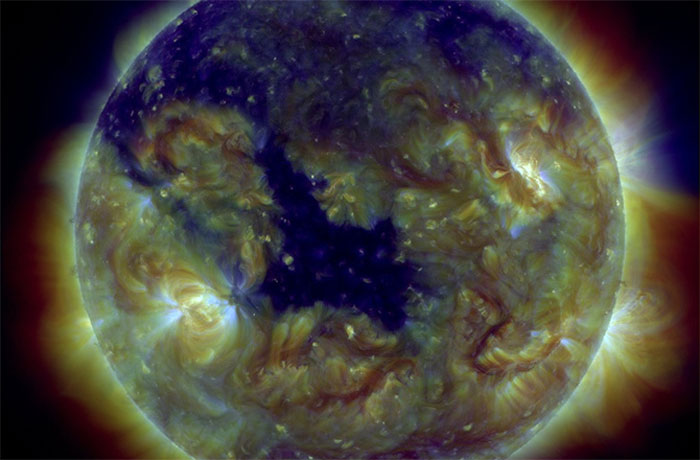.

A composite image of the sun's corona on Oct. 4 using filters sensitive to 3 different wavelengths of EUV emissions from the sun's corona. Bright regions in the lower corona highlight "active regions" where flares and coronal mass ejections are likely to be triggered over sunspots in loops of magnetic fieldlines. Dark regions highlight areas of "open" fieldlines where plasma is escaping to space as the fast solar wind.
-
Yes, that’s right, there’s a hole in the sun, but it’s not a sign of anything scary, it’s actually a wonderful insight to some pretty “cool” solar dynamics.
Imaged by NASA’s Solar Dynamics Observatory through filters that are sensitive to extreme ultraviolet light, this huge dark spot in the center of the sun’s disk is a low density region of plasma in the sun’s corona (the sun’s multimillion degree magnetized atmosphere).
The solar corona is a magnetically-dominated region, populated with “open” and “closed” magnetic field lines, that protrude from the sun’s interior and into the corona, along which the super-heated plasma is guided. The bright regions in this image are locations of closed field lines, known as coronal loops. Dense plasma is trapped in these elegant loops, being heated, generating intense radiation.
However, in this observation of the sun, an obvious dark patch has rotated into view, a sign that density is low and the hot plasma is escaping from the corona into interplanetary space.
Coronal holes are the source of the fast solar wind that can impact space weather at Earth, and this coronal hole shows that a stream of high-velocity plasma (highly-energetic particles composed mainly of protons) is headed our way. The magnetic field in coronal holes act like a fire-hose, spraying coronal plasma away from the sun as it rotates, spiraling through the solar system.
According to Spaceweather.com, plasma from this coronal hole will reach Earth orbit on Oct. 8-9. It’s possible that, depending on magnetic conditions, arrival of this stream of fast solar wind may intensify auroral activity in high latitudes.
Like solar flares and coronal mass ejections (CMEs), intense bursts of solar wind activity can increase the radiation environment surrounding Earth, impacting sensitive electronics in satellites and spacecraft. The SDO and armada of other solar observatories such as the NASA/ESA Solar and Heliospheric Observatory (SOHO) and Japanese Hinode space telescopes are on constant watch for explosive events in the corona and the presence of coronal holes so space weather can be better predicted before it impacts Earth.
Quelle: D-News
4488 Views
